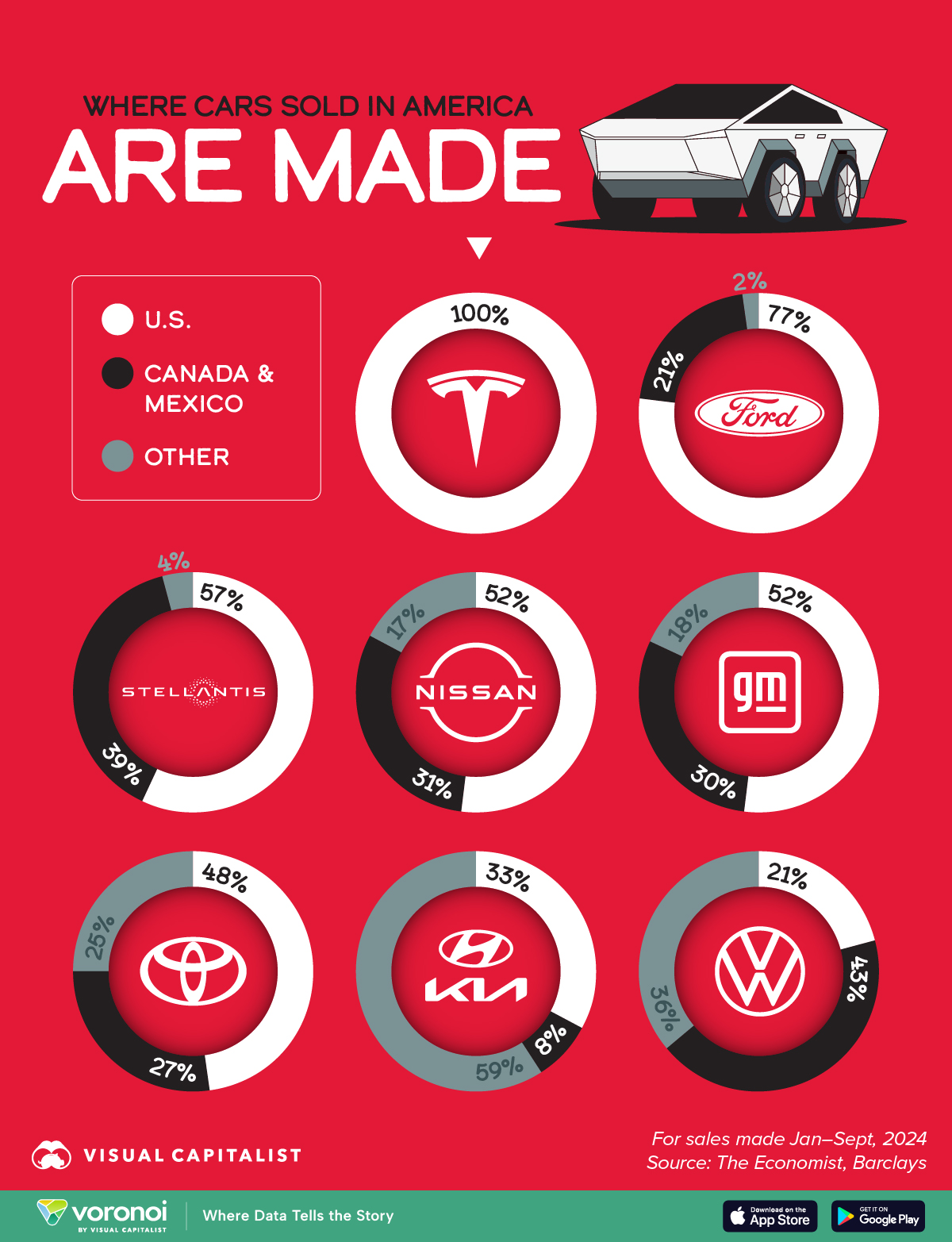![]()
See this visualization first on the Voronoi app.

Use This Visualization
Visualized: Where Automakers Build Cars Sold in America
This was originally posted on our Voronoi app. Download the app for free on iOS or Android and discover incredible data-driven charts from a variety of trusted sources.
Key Takeaways
- Tesla assembles all its cars sold in the U.S. within the country.
- As a result, it will see minimal impact from proposed Trump tariffs.
- Between 25–33% of Big Three U.S. cars sold in 2024 were manufactured in Mexico or Canada.
Few would have predicted how car manufacturing supply chains would be put under the spotlight in 2025.
And yet with looming Trump tariffs, the North American car industry has had its logistics laid bare: with supply chains criss-crossing the Mexico and Canada borders, sometimes multiple times for the same car.
To bring some data to this discussion, we visualize where cars sold in America are made by major automakers. Data for this chart is sourced from The Economist.
Who is the Most American Automaker?
Tesla has regularly claimed it’s the most American manufacturer. And the data says it’s true: for cars sold in the U.S. at least.
The below table lists where the cars sold in America between January and September 2024 were assembled for eight major automakers.
| Assembled in the U.S. | Assembled in Canada or Mexico |
Assembled Elsewhere | |
|---|---|---|---|
| Tesla | 100% | 0% | 0% |
| Ford | 77% | 21% | 2% |
| Stellantis | 57% | 39% | 4% |
| Nissan | 52% | 31% | 17% |
| General Motors | 52% | 30% | 18% |
| Toyota | 48% | 27% | 25% |
| Hyundai-Kia | 33% | 8% | 59% |
| Volkswagen | 21% | 43% | 36% |
Not only does Tesla assemble 100% of all the cars sold in America within the U.S., it also sources 60-70% of its parts from within the country as well.
Thus, proposed tariffs on Canada and Mexico—currently paused till April—will likely have minimal impact on the company.
However, the other Big Three automakers (Ford, GM, and Stellantis) cannot say the same.
Between 25-33% of all U.S. vehicles sold by them are sourced from across one of the two borders. And this doesn’t even go into parts used for manufacturing.
The Supply Chains of Global Manufacturing and Tariffs
The simple reason why supply chains are so globalized: it’s cheaper.
The creation of the North American free trade zone allowed automakers to make use of relatively inexpensive labor and manufacturing setups in other countries.
As a result Canada and Mexico emerged as auto hubs. But things have become increasingly complex: for example, American-made engines and transmissions are shipped across to Canada, and then assembled into a car which is then shipped back to be sold to U.S. customers.
Aside from tariffs looming on any car not assembled within the country, tariffing the back-and-forth of parts is a separate concern.
And as this New York Times article breaks down: many cars assembled in the U.S. may use a majority of foreign-sourced parts, and vice-versa.
Learn More on the Voronoi App ![]()
Keep up with tariff news, with a data lens to better inform your opinions. Check out: How Reciprocal Tariffs Can Hurt Major Asian Economies to see the other brewing trade war.
The post Visualized: Where Automakers Build Cars Sold in America appeared first on Visual Capitalist.